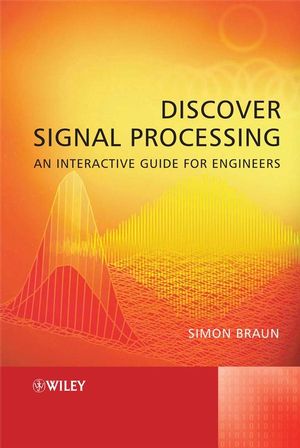|
Textbook
Discover Signal Processing: An Interactive Guide for EngineersISBN: 978-0-470-51970-7
Hardcover
366 pages
March 2008, ©2008
 |
||||||
About the Author.
Notation.
Part A: The Exercises.
1 Introduction.
Overview.
The Exercises.
Exercise 1.1.
Exercise 1.2.
Solutions and Summaries.
2 Signals.
Overview.
The Exercises.
Exercise 2.1.
Exercise 2.2.
Exercise 2.3.
Exercise 2.4.
Solutions and Summaries.
3 Fourier Methods.
Overview.
The Exercises.
Exercise 3.1.
Exercise 3.2.
Exercise 3.3.
Exercise 3.4.
Exercise 3.5.
Exercise 3.6.
Exercise 3.7.
Exercise 3.8.
Exercise 3.9.
Exercise 3.10.
Exercise 3.11.
Exercise 3.12.
Solutions and Summaries.
4 Linear Systems.
Overview.
The Exercises.
Exercise 4.1.
Exercise 4.2.
Exercise 4.3.
Solutions and Summaries.
5 Filters.
Overview.
The Exercises.
Exercise 5.1.
Exercise 5.2.
Exercise 5.3.
Exercise 5.4.
Solutions and Summaries.
6 Time Domain Averaging (TDA).
Overview.
The Exercises.
Exercise 6.1.
Exercise 6.2.
Exercise 6.3.
Exercise 6.4.
Solutions and Summaries.
7 Spectral Analysis.
Overview.
The Exercises.
Exercise 7.1(a).
Exercise 7.1(b).
Exercise 7.2.
Exercise 7.3.
Exercise 7.4.
Exercise 7.5.
Exercise 7.6.
Exercise 7.7.
Exercise 7.8.
Exercise 7.9.
Solutions and Summaries.
8 Envelope Detection.
Overview.
The Exercises.
Exercise 8.1.
Solutions and Summaries.
9 The Spectrogram.
Overview.
The Exercises.
Exercise 9.1.
Exercise 9.2.
Solutions and Summaries.
10 Sampling.
Overview.
The Exercises.
Exercise 10.1.
Exercise 10.2.
Exercise 10.3.
Exercise 10.4.
Solutions and Summaries.
11 Identifi cation – Transfer Functions.
Overview.
The Exercises.
Exercise 11.1.
Exercise 11.2.
Exercise 11.3.
Exercise 11.4.
Solutions and Summaries.
12 Model-based Signal Processing.
Overview.
The Exercises.
Exercise 12.1.
Exercise 12.2.
Exercise 12.3.
Solutions and Summaries.
13 Diagnostic Applications for Rotating Machines.
Overview.
The Exercises.
Exercise 13.1.
Exercise 13.2.
Exercise 13.3.
Exercise 13.4.
Exercise 13.5.
Solutions and Summaries.
14 Systems with Delays.
Overview.
The Exercises.
Exercise 14.1.
Exercise 14.2.
Exercise 14.3.
Solutions and Summaries.
Part B.
1 Introduction.
1.1 General Objectives.
1.2 Basic Processing.
1.3 Why the Frequency Domain?
1.4 An Introductory Example.
2 Introduction to Signals.
2.1 Signal Classification.
2.2 Signal Descriptions.
2.3 Correlation Functions.
2.4 Estimation and Errors.
3 Fourier Methods.
3.1 Fourier Series.
3.2 Fourier (Integral) Transform.
3.3 The Uncertainty Principle.
3.4 The Discrete Fourier Transform (DFT).
3.5 The DFT and the Fast Fourier Transform (FFT).
3.6 Discontinuities and Windows.
4 Linear Systems.
4.1 Continuous Systems.
4.2 Discrete Systems.
4.3 A Specifi c Case of a Continuous Linear Systems – Accelerometers.
Appendix 4.A The Lightly Damped SDOF System.
5 Filters.
5.1 Preliminaries.
5.2 Analog and Digital Filters.
5.3 Filter Classifi cation and Specifications.
5.4 IIR Filters.
5.5 FIR Filters.
5.6 The Importance of Linear Phase Filters.
5.7 Design Tools.
6 Time Domain Averaging (Synchronous Averaging).
6.1 Principle.
6.2 Rejection of Nonsynchronous Components.
6.3 TDA with Decaying Memory Process.
7 Spectral Analysis.
7.1 Introduction.
7.2 Representation of Signals in the Frequency Domain.
7.3 Errors and their Control.
7.4 Spectral Analysis: Practical Considerations.
8 Envelopes.
8.1 Introduction.
8.2 The Hilbert Transform (HT).
8.3 Analytic Signals.
8.4 Narrow Band (NB) Signals and their Envelope.
9 The Spectrogram.
9.1 Introduction.
9.2 Time Frequency Methods.
9.3 The Short Time Fourier Transform (STFT) and the Spectrogram.
10 Data Acquisition.
10.1 Data Acquisition and Signal Processing Systems.
10.2 Amplitude Quantization.
10.3 Quantization in Time: The Sampling Theorem.
10.4 Antialiasing Filters.
11 Input/Output Identifi cation.
11.1 Objectives and Overview.
11.2 Frequency Domain Identifi cation: The Noiseless Case.
11.3 Identifi cation with Noise Corrupted Signals.
11.4 Error Mechanisms and their Control in the Identifi cation Process.
11.5 Estimation Errors for the Coherence Function.
12 Model-based Signal Processing.
12.1 General.
12.2 Signal Models.
12.3 Modeling of Signals.
12.4 Model-based Spectral Analysis.
12.5 Model or Selection.
12.6 Model-based Diagnostics.
Appendix 12.A The Correlation Matrix.
13 Machinery Diagnostics: Bearings and Gears.
13.1 Diagnostics and Rotating Machinery.
13.2 Structural Effects.
13.3 Rotating Imbalance.
13.4 Modeling of Roller Bearing Vibration Signals.
13.5 Bearing Vibrations: Structural Effects and Envelopes.
13.6 Modeling of Gear Vibration Signals.
14 Delays and Echoes.
14.1 System with Pure Delays.
14.2 Correlation Functions.
14.3 Cepstral Analysis.
References.
Index.



